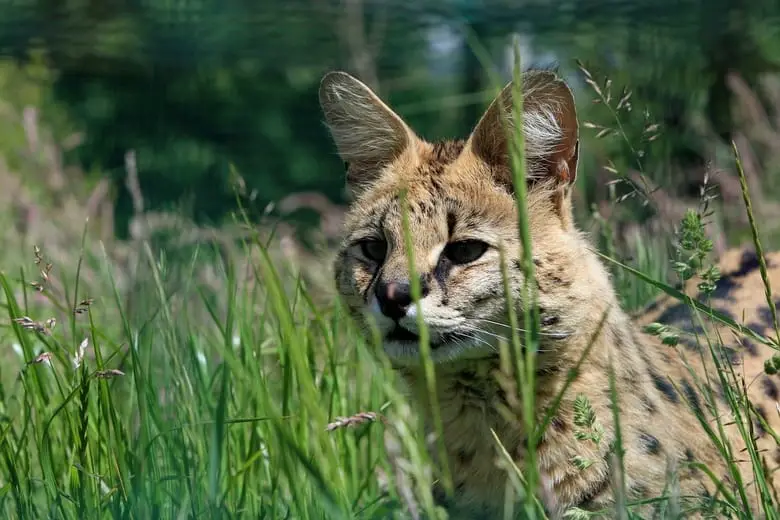Unless you own your own zoo, keeping and caring for a full sized pet cheetah is likely not in the cards for you. This is probably for the best. Cheetahs are wild cats, and keeping any wild animal is not a risk many of us are equipped to take.
Fortunately, for those of us who’ve always dreamed of keeping a pet cheetah, there are a number of cats that look like cheetahs but make better pets than their wild cousins.
Notably, many of the breeds on our list are crossbreeds between other wild cat species and domestic cats, a fact that contributes to their cheetah-like appearances.
Cats That Look Like Cheetahs
Even though these breeds can be kept as pets, it is still important to note that a few retain characteristics of their wild parentage, and may not be as tame as their fully domesticated counterparts.
1. Ocicat
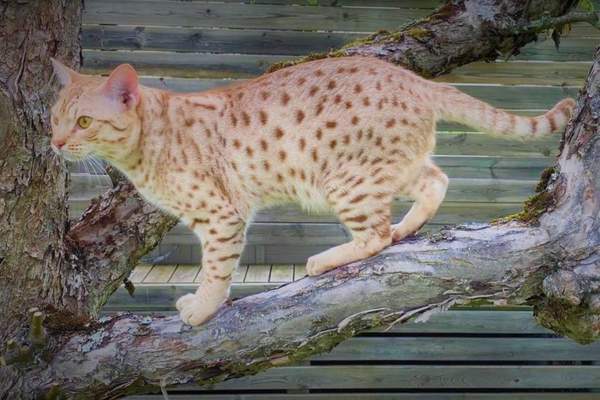
Average Lifespan: 15-18 years
Average Size: 6-9 pounds
Coat: fine, short
The Ocicat, unlike some of the others on this list, is a cat breed that has been fully domesticated yet still bears a resemblance to wild cats. Its name is derived from its superficial resemblance to the Ocelot, a wild cat species from South America.
A genetic accident, the Ocicat was developed in the United States in 1964 when a breeder attempted to combine Abyssinian and Siamese breeds. The pairing resulted in otherwise Abyssinian-looking kittens, with the exception of one individual which bore the Ocicat’s trademark spots.
The Ocicat has a light frame and thin body, two traits inherited from its Siamese and Abyssinian lineages.
The breed’s head is an almond shaped and the cat is known for having proportionally large eyes. It’s fur is fine and bears elongated spots, contributing to its superficial resemblance to other wild cats.
This breed’s striking coat pattern and appearance is unique among fully domesticated house cats, and the fact that it is well suited to indoor life makes it a great alternative to some of the wild mixes on this list.
Another bonus with this breed is its availability. As a domestic cat, finding and acquiring an ocicat is far easier than hybrid breeds, which were only more recently developed. It is known to be a healthy breed.
2. Savannah Cat
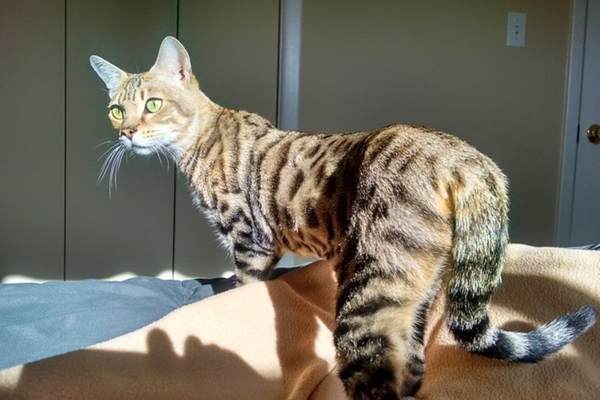
Average Lifespan: 15-20
Average Size: 12-25 pounds
Coat: short, fine
The Savannah cat is a hybrid breed produced between a domestic house cat and a Serval, which is a wild cat species that can be found in the northern regions of Africa.
The Serval is larger than a domestic cat, possesses broad ears, and is known for its spotted pattern. The overall body size, ears, and appearance of the Serval are characteristics that are also consistent in savannah cats.
The Savannah cat, while a mix of the Serval and domestic cat breeds, does not always have a parent from each species. There have been numerous generations of savannah cats and most of the individuals available have two parents that are already mixed.
This process of multi-generational breeding has allowed breeders to select for characteristics that best suit life in captivity. The Savannah cat is larger than many domesticated cat breeds and has a slight frame with an elongated body that is flexible and toned.
This mix is known to be a healthy breed. Due to the black spots on its tan fur, this breed, more than most of the other cats that look like cheetahs, has a particularly wild appearance.
In terms of temperament and behavior, the Savannah cat is known to be curious and inquisitive. Many owners of the breed have also noted that their savannahs will follow them around the house and are extremely loyal.
Unlike with other cat breeds, savannah cats have been known to respond well to leash training, and it has been observed that some individuals actively enjoy going on walks with their owners.
3. Egyptian Mau
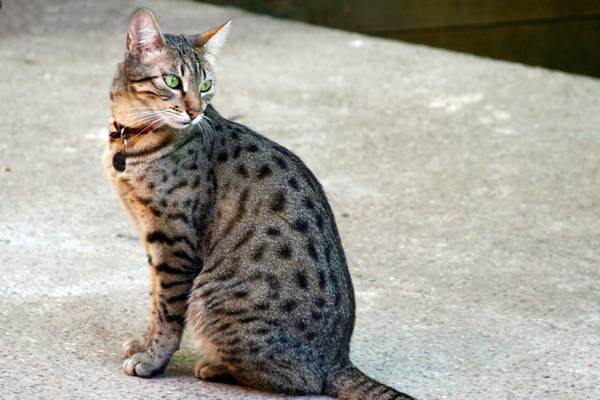
Average Lifespan: 9-13 years
Average Size: 8-12 pounds
Coat: short, fine
Like the Ocicat, the Egyptian Mau is another fully domesticated cat breed on this list. One of the rare fully domesticated breeds with naturally occurring spots, it’s no wonder that the Egyptian Mau has drawn comparisons with cheetahs.
However, unlike the Cheetah, the Egyptian Mau possess a single, long dorsal stripe that stretches along its spine. Despite its superficial similarities with the Ocicat, this breed is considered to be only distantly related.
Like the former, the Egyptian Mau is also a small to medium breed that has a thin frame and is light in weight. These characteristics, in addition to its disproportionately long back legs, make the Egyptian Mau the fastest of all domesticated cat species.
Owners of the breed comment on its playful and curious nature, as well as its loving and dutiful relationship with its family. While Egyptian Maus do well in most indoor environments, they tend to prefer warmer areas or heated objects, which they will spend a significant amount of time hanging around.
An incredibly expressive breed, the Egyptian Mau is known for being vocal, communicating its mood and affection through chirps and by purring.
It has also been recognized that many individuals will twitch their tails when excited or happy. Found in the Egyptian Mau but uncommon to other breeds, is the Egyptian Mau’s facial expressions, which will often reflect the cat’s mood.
Unfortunately, the breed has a shorter lifespan than other cats on this list.
4. Serengeti Cat
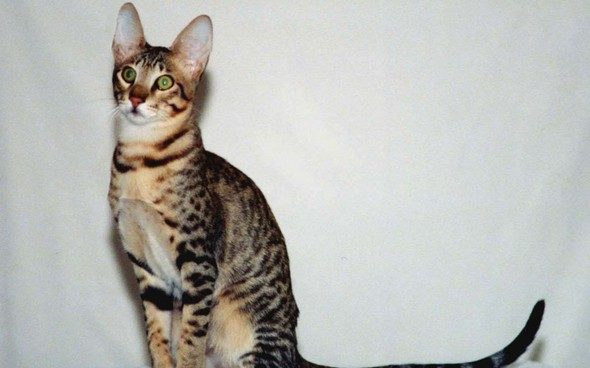
Average Lifespan: 10-13 years
Average Size: 8-15 pounds
Coat: short, fine
The Serengeti cat is a breed originally created from a cross between the Bengal and Oriental Shorthair. The Bengal is itself a cross between the Egyptian Mau and the Asian leopard cat, which is a wild species of cat that is common throughout much of Asia.
As with some of the other cats that look like cheetahs, the Serengeti cat owes its unique appearance to wild ancestry.
Farther removed from wild cat species than breeds like the Savannah cat, the Serengeti cat is a more tame breed accustomed and well suited to domestic and family life with many of the characteristics of domestic cats.
Originally developed in 1994, this breed is still under development and certain features, such as its large and rounded ears, are being selected and refined by breeders. Aside from its prominent ears, the Serengeti cat also possesses a longer than average neck that does not taper, but is of a consistent width leading up to the skull.
In part because of its desirable appearance and owing to its somewhat recent development, the Serengeti cat is not widely available and is a relatively rare breed that can be quite expensive to acquire.
Perhaps because of its Egyptian Mau parentage, the Serengeti cat is also known for having a shorter lifespan than many other cat breeds.
5. African Serval
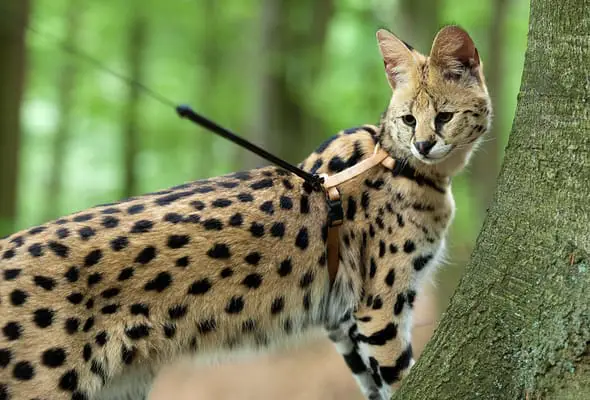
Average Lifespan: 12-20 years
Average Size: 20-26 pounds
Coat: short, sleek
As you may already have realized from our discussion of the Savannah cat, the African Serval is not a cross between domestic and wild cats.
If you don’t recall, it may surprise you to learn that the African Serval is itself a wild species of cat. Knowing this, you may also be wondering if it’s possible and legal to own one of these majestic creatures.
Notably, and in part due to efforts to create the Savannah cat, the African Serval has been bred in captivity for traits that make it a more suitable household companion, and one that is amenable to the company of humans.
Needless to say, the project has produced individuals with the desired characteristics, effectively making owning a wild cat species feasible for some people. That said, the African Serval is still a wild cat and will have exercise and space requirements that exceed that of a fully domesticated cat and others on this list.
These animals are natural hunters and are accustomed to stalking and hunting prey, so it is not recommended to keep them with other animals. Perhaps, of all the cats that look like cheetahs on this list, the African Serval is the closest you can get in appearance and temperament to owning an actual cheetah.
However, this species is rare to find available for purchase from captive stock, and should only be kept by people who have experience with handling and keeping wild animals.

